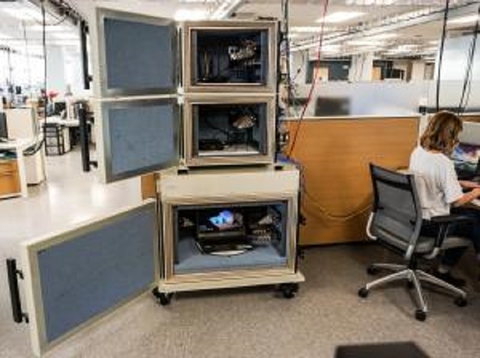The University of New Hampshire InterOperability Laboratory (UNH-IOL) has introduced a new set of Wi-Fi testing capabilities, reflecting a movement to help service providers and gateway vendors enhance broadband customers’ Wi-Fi broadband experience.
These new Wi-Fi testing capabilities are made possible through UNH-IOL’s acquisition of test and measurement equipment from Octoscope.
By leveraging Octoscope’s equipment, UNH-IOL is aiming to enable repeatable, real-world Wi-Fi scenario testing to satisfy the growing end-user expectations for increased high-capacity, low-latency wireless broadband services.
RELATED: UNH-IOL launches in-house automated Gfast, DSL testing platform
As Wi-Fi has become the de facto in-home connectivity medium from cable operators and traditional telcos, broadband users view wireless performance as a key factor of their overall broadband internet experience.
Lincoln Lavoie, senior engineer UNH-IOL, told FierceTelecom that service providers and wireless gateway vendors are taking more notice in delivering in-home Wi-Fi connectivity for their broadband customers.

“You’re seeing a lot of the service providers and the equipment vendor community focus on wireless, especially in broadband deployments because it is really becoming analogous of what it means to be connected to the network,” Lavoie said. “Performance is a crucial factor in measuring the user’s quality of experience (QoE).”
“As the industry moves to a more agile development cycle and upgrading firmware versions, it makes it easier for people to have a continuous checking of the technology and see how things are performing,” Lavoie said. “You’re also seeing service providers bring some of these types of services into the portfolio in terms of selling that connected home or Wi-Fi in the home performance and all those things drove us to target these new Wi-Fi testing capabilities.”
Widening in-home coverage
To address consumers’ desire for higher speed Wi-Fi and network reliability, the advent of new standards like IEEE 802.11ac will start to have an impact.
The standard has multistation throughput of at least 1 Gbps and single-link throughput of at least 500 Mbps as well as greater range inside of a home.
UNH-IOL said the advent of new wireless technologies like IEEE 802.11ac, has increased the number of factors that can directly impact Wi-Fi performance.
At the same time, the advent of router and gateway vendors developing wireless repeaters that allow users to further enhance Wi-Fi coverage in a home. Some vendors like eero have a product that can automatically connects to one another to create a single wireless mesh network that covers the home. A set of three eeros will typically cover the average home (3,000-4,000 square feet), for example.
“We have seen with 802.11ac where there’s only the 5 GHz technology, customers get a slight decrease in coverage in terms of range and penetrating through walls because of that increase in the frequency,” Lavoie said. “That’s what’s driving the push to have those wireless repeaters in the home.”
Lavoie added that testing the capabilities of repeaters will be the next area UNH-IOL’s Wi-Fi broadband testing.
“I think that’s going to probably be the next approach to the testing where you’re seeing the industry really push for having multiple access point solutions in broadband deployments to get that coverage into larger homes,” Lavoie said.
Several technology forums have been developing protocols to manage the interactions between access points and repeaters inside of a home like what would exist in a business’ LAN.
“There is some work that has been started inside technical organizations for client steering protocols,” Lavoie said. “These would direct which client and which AP would be connected to create almost like what you would have in a corporate network where all the APs work together.”
But when it comes to whole home Wi-Fi coverage, there are regional differences due to the way homes are built.
In the United States, the ability for wireless signals to penetrate walls is not as challenging because builders typically build walls made with sheet rock. However, in Europe which has a lot of brick construction, Wi-Fi connectivity can be more challenging.
“Obviously, in North America we tend to have a lot of sheet rock construction,” Lavoie said. “If you get into Europe, you get into a lot of masonry in older cities and the stone in the concrete can deaden out wireless signals even quicker than what you would have in the North American market.”
Focus on QoE
Since many consumers see Wi-Fi connectivity as being their internet connection, ISPs are usually blamed when streaming video music sessions begin to buffer or drop off completely.
U.K.-based competitive provider TalkTalk says being able to measure Wi-Fi connectivity will enable it to give its customers a better internet experience in the home.
“Robust testing and measurement is key to the continuous improvement of broadband services, and WIFI performance has become critical to that equation,” said Pete Beynon, principal network services engineer of TalkTalk in a release. “In turn, this will help ensure providers continue to meet consumers’ growing demand for faster, more reliable services.”

Given the convenience of streaming video services from tablets and smart phones inside the home, the amount of devices used to access the internet inside of homes via Wi-Fi continues to rise. As more people connect to an access point in the home, there’s a potential for network performance to become degraded.
“The thing that a lot of testing is starting to focus around is what we’re calling quality of experience bundle,” Lavoie said. “It’s not just performance of how fast can a single access point go, but it’s also what happens when you have the AP under a greater load of clients joining and leaving.”
